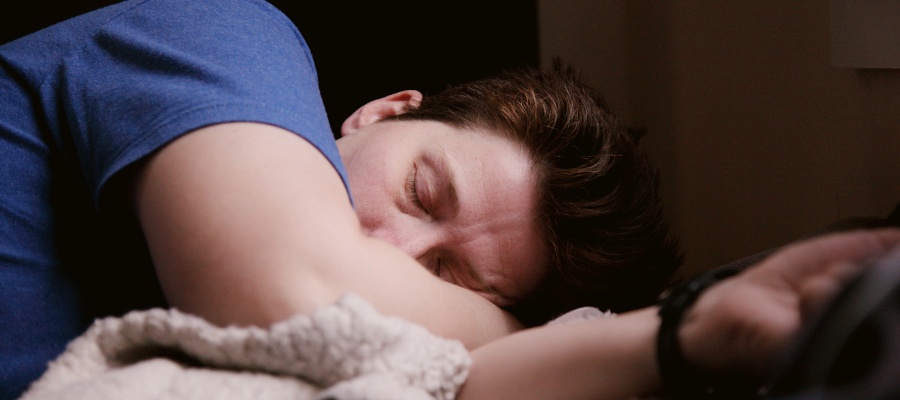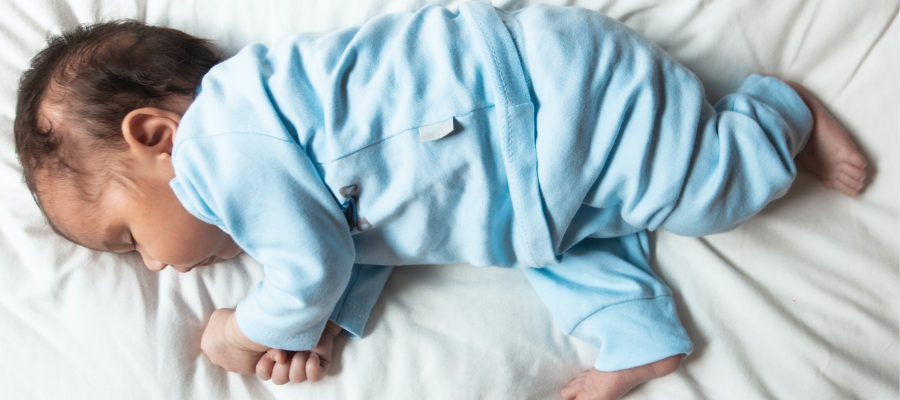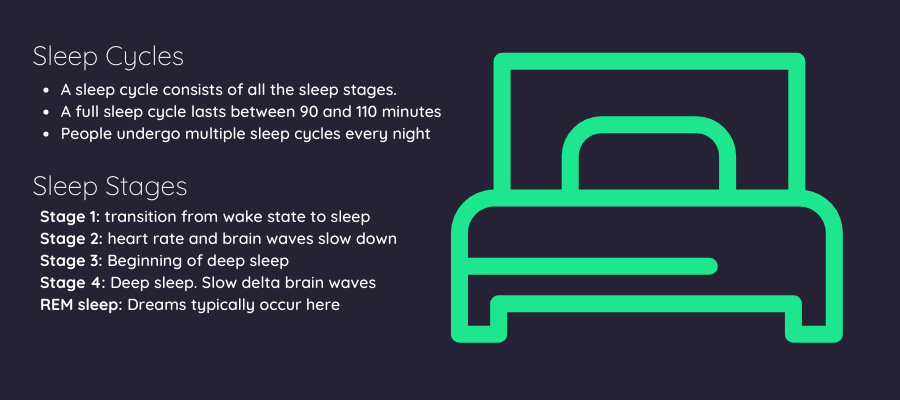Sleep Cycles: How the Sleep Stages affect Your Health
A sleep cycle is a progression through the various stages of sleep from Non-REM sleep to REM sleep before beginning the progression again with Non-REM sleep. A sleep cycle typically lasts between 90 to 110 minutes and is made up of four sleep stages. This means that most people will go through multiple sleep stages every night.
Full cycles featuring all the five stages of sleep is essential for health and wellbeing. During sleep, our short-term and long-term memories are consolidated, our bodies regenerate, and our immune system is working at its hardest. For this reason, it makes sense to improve one’s sleep quality as much as possible within the framework of one’s everyday life and avoid sleep deprivation.

What are the 5 Stages of Sleep?
There are 5 stages of sleep in each sleep cycle: Non-REM (NREM) Sleep (Stages 1, 2, 3 & 4) and REM Sleep.
Stage 1: Light sleep. This is the lightest stage of NREM sleep and is the transition from the waking state to sleep. As our body relaxes, brain wave activity begins to slow down compared to when awake. This sleep stage is easily disrupted by short awakenings. You may also experience so-called hypnic jerks, a sudden jerk of the entire body or one body segment such as an arm or leg, or muscle spasms.
Stage 2: This is the first pronounced NREM sleep stage in which you are no longer awake. Your body temperature begins to decrease and your heart rate begins to slow. Your brain waves also continue to slow down. There are specific bursts of rapid activity known as sleep spindles mixed with sleep structures known as K complexes. Sleep researchers believe both sleep spindles and K complexes protect the brain from awakening from sleep. It’s less common to wake up during this sleep stage though it’s still relatively light sleep.
Stage 3: is the beginning of deep sleep. Your brain starts to produce delta, or slow waves, and you won’t experience eye movement or muscle activity. It is difficult to wake someone up from Stage 3 sleep.
Stage 4: Deep, non-rapid eye movement sleep. In stage 4 sleep, as your brain produces more delta waves, and you respond to external stimuli even less. This is the most difficult stage of sleep to wake up from. Parasomnias (sleep walking, sleep talking and night terrors) occur during this deepest stage of sleep.
REM sleep (stage 5)
REM sleep, also known as Rapid Eye Movement, is our dreaming state. Brain waves are more active than in Stages 2 & 3 and eye movements are more rapid. Awakenings occur more easily although if you wake during the middle of a REM period, you might feel groggy. This is called sleep inertia and it can last anywhere from 15 minutes to several hours. REM sleep can occur at any time but it usually begins about 90 minutes after you first fall asleep.
You will typically go through four or five sleep cycles at night. You will stay in REM sleep for longer periods with each cycle.
The importance of the sleep stages

The stages of sleep are important because our bodies are repairing muscles, stimulating growth, boosting our immune systems and energizing for the next day. Again, keep in mind that the average human undergoes several sleep cycles, comprising all the stages of sleep every night. Therefore, make sure you get a good night’s sleep.
When do I dream?
Our most vivid dreams happen during REM sleep, so a person might have dreams four to five times every night. Many times, we will not remember our dreams, unless we were woken up during REM sleep.
REM sleep is often accompanied by muscle paralysis. This is considered to be a protective measure to prevent us from getting hurt while trying to act out our dreams. Many people with Obstructive Sleep Apnea experience it the worst during REM as the relaxed muscle tone works to obstruct airways the most.
READ ALSO: WHAT IS A NAPPUCCINO?
Sleep changes with age

Sleep needs change from newborn through the toddler and school age years to adulthood. Read about age-specific sleep patterns below.
Childhood
Newborn (birth – approximately 4 months): In these early days, babies do not have distinctive sleep waves. Sleep is separated into “Active” or “Quiet” sleep. Active sleep is similar to REM sleep and Quiet sleep is the equivalent of non-REM sleep. The majority of newborn sleep is spent in active sleep, which allows for frequent awakenings which is necessary for regular feeding. Newborns can spend 14-18 hours a day asleep!
Infants (approximately 4 months – 1 year): During this phase, a baby’s sleep stages become more apparent as sleep consolidates into a longer night sleep with 2-3 daytime naps. Infants typically sleep 13-15 hours in a 24-hour period.
Toddlers (1 year – 3 years): As toddlers establish set sleeping patterns, they will spend almost equal time in Stage 3 deep sleep as they do in REM sleep. During this time, daytime naps usually drop to once in the early afternoon. Toddlers will sleep about 12-14 hours in a 24-hour period.
Preschool (3 years – 6 years): The biggest change in sleep during the preschool years is that most kids will drop their daytime nap. They will still spend the majority of sleep in Stage 3 sleep for a total of about 10-12 hours in a 24-hour period.
School Age (6 years – 12 years): The composition of sleep remains the same with Stage 3 deep sleep accounting for approximately 20-25% of their total sleep time. This restorative sleep is critical for kids’ growth and development. School Age kids need about 10-11 hours of sleep per day.
Teenagers and adults
Adolescent (12 years+): Teenagers experience a shift in their circadian rhythms that causes later sleep onset. This physiological change means many adolescents will go to bed later but want to “sleep in” later in the mornings. Overall sleep needs remain around 8-10 hours a day.
Adulthood: As we become adults, our circadian rhythms shift back again and in a 24-hour period, adult sleep needs vary from 6-9 hours each night. Older adults (65+) may experience even less sleep although this does not necessarily mean they do not need as much, but various factors may inhibit sleep as we age.
Different sleep patterns
Sleep cycles are not one-size-fits all. Different cycles go with different ages, so although the answer to how many sleep cycles a human undergoes each night is generally the same, the content of each sleep cycles may vary considerably.
Be mindful towards sleep calculators and other too-simplistic sleep cycle representations when you do your research. If you suffer from sleep apnea, chronic sleep deprivation or experience excessive sleep inertia, seek medical attention.


